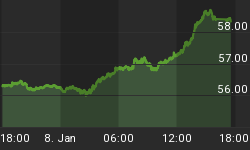The good news is:
* The current decline appears to be heading to an extreme whichwill provide a good long side entry, soon.
Last week I was somewhat optimistic because new lows diminished in the previous weeks rally. That optimism was premature. New lows increased every day except Thursday on the NASDAQ and every day except Tuesday on the NYSE. New lows are now at threatening levels on both exchanges.
The chart below shows the NASDAQ composite with the new low indicator. The new low indicator is a 10% trend (19 day EMA) of NASDAQ new lows plotted on an inverted Y axis.
It is prudent to wait until there have been five consecutive up days on the new low indicator before taking a long position. The late July rally in the indicator lasted four days.

A summation index (SI) is a running total of oscillator values. When the oscillator is positive its SI rises, when the oscillator is negative its SI falls. SI's do not lead, but do a good job of smoothing the often violent action of oscillators and prices.
The chart below shows SI's derived from oscillators of NASDAQ advances - declines, new highs - new lows and upside - downside volume. The SI's began turning upward at the end of July, but the rally failed. I have circled another period in late February when there was a similar occurrence.

The chart below shows the NASDAQ composite and a 4% trend (55 day EMA) of downside volume. The indicator is plotted on an inverted Y axis so increasing downside volume moves the indicator downward. There have been other peaks in the indicator this year that have corresponded with the March low and the April-May low. It would be nice to see this indicator reach the March and April-May levels because that has corresponded with the earlier "get me out at any price" lows.

There has been no evidence of a bottom and the seasonal bias for the second week in August is slightly negative.
I expect the major indices to be lower on Friday August 13 than they were on Friday August 6.
Gordon Harms produces a Power Point on current market conditions for our monthly FastTrack user group meetings. You can download the current one from: http://www.guaranteed-profits.com.
















